Comparing Apex Legends' World's Edge Map to Season 7's Olympus

It's been two weeks now since Apex Legends entered its seventh season, bringing a wave of new content to Respawn Entertainment's popular battle royale game. Like many of Apex Legends' previous seasons, the new one introduces a new battle pass and Legend, but it also introduces a brand new map, which is only the third to be added to the game so far.
The new map is Olympus, an abandoned floating city high above the Outlands planet of Psamathe. Respawn Entertainment has been teasing the map for some time, mostly through appearances in trailers for previous seasons, loading screen text, and the Broken Ghost quest. Back in October, the distinctive red aircraft that can be found in Olympus were added to the backgrounds of the Kings Canyon, World's Edge, and Firing Range maps.

The once-opulent city of Olympus was abandoned after a Phase Rift threatened to destroy it. The disaster was centered around a Phase research station, in the Phase Gateway region of the city, yet players will be able to use this Phase Rift to teleport by getting up close and personal in the Rift region.
Before its abandonment, Olympus featured heavily in the backstories of several of Apex Legends' Legends. It was once the home of Lifeline, Octane, and new Season 7 Legend Horizon. In addition, Olympus is also the city in which Revenant murdered Loba's parents in the Reverie Lounge restaurant.
As a once-wealthy and opulent floating city, Olympus has retained much of its shine even after being abandoned. The entire map has a sculptured, geometric beauty to it, a far cry from the functional, rough-edged architecture of World's Edge. All the streets and parks in Olympus are neatly laid out in overlapping geometric patterns, bordered by triangles of verdant grass and overgrown gardens.
With its huge variety of cultured and synthetic flora, Olympus is certainly the most colorful of Apex Legend's three maps. The drab grass and volcanic soil of World's Edge is left behind, and every building in Olympus just reinforces how luxurious the city was. Interiors are awash with brushed metal, flawless glass, anti-gravity chandeliers and stunning views of the surrounding cloudscapes. Overall, Olympus has a radically different look to Apex Legends' World's Edge, highlighting the disparity between the different societies that once occupied the derelict maps.

While Olympus is larger than King's Canyon, Apex Legends' first map, it's actually slightly smaller than World's Edge. Overall, the map is also a lot more open than Apex Legends' previous battlegrounds, allowing longer sightlines. However, just like in World's Edge, the areas are laid out to give players several options for rotation. Making rotations will be aided by the new Trident vehicle, a three-player hovercar that arrived with the Olympus map.
While the many gaps in the city's baseplate will funnel players into specific crossing points, they don't block sight like World's Edge's towering mesas. However, this doesn't mean that Olympus lacks verticality. In fact, it's quite the opposite. Despite essentially being a floating plate in the sky, Olympus has plenty of height difference between its many regions. Some, like the Hammond labs, sit in the center of artificial valleys, while others, such as Bonzai Plaza, feature towering skyscrapers that work perfectly with the Kraber 50. Cal Sniper.
Overall, Olympus is a very different map to World's Edge and Kings Canyon, both in appearance and gameplay. The roughly-circular design of the city allows for interesting rotation choices, and there's plenty of well-placed ziplines to get players where they need to go. In addition, the broad, open spaces are tailor-made for the new Trident vehicle, giving teams the opportunity to quickly relocate.
Apex Legends is available now on PC, PS4, and Xbox One, with Mobile and Switch versions in development.

Post a Comment